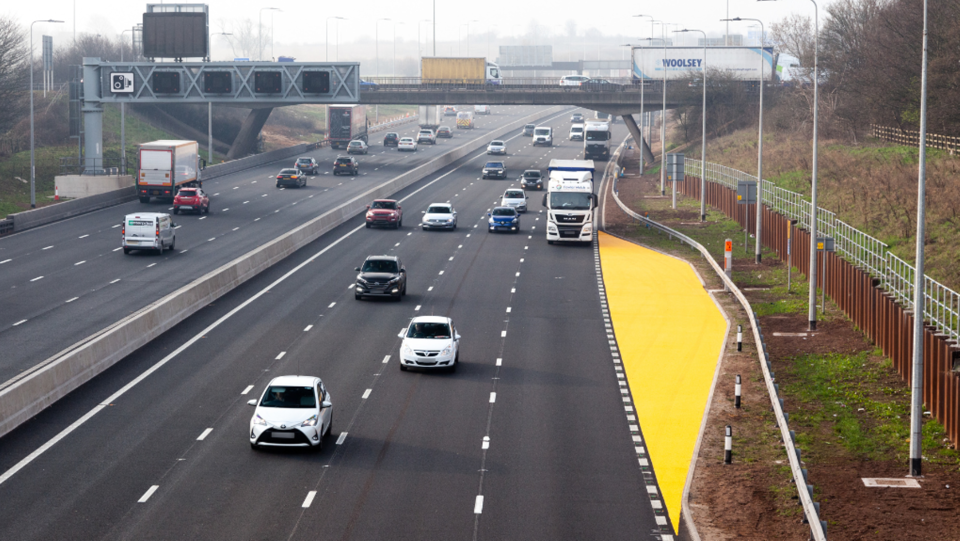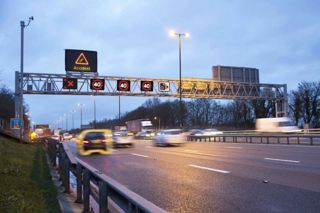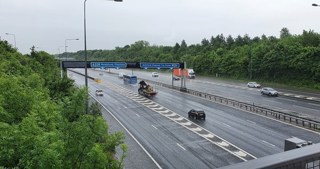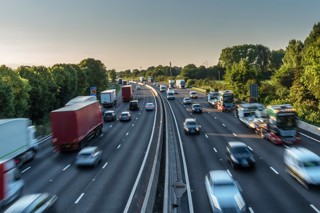Problems with the technology used on smart motorways to identify stopped vehicles in live lanes have been flagged by the Office of Rail and Road (ORR) in a safety report.
Stopped Vehicle Detection (SVD) technology is radar-based technology that is on every all lane running (ALR) smart motorway where the hard shoulder has been permanently converted to a live traffic lane.
The regulator reports that National Highways had the technology in place on every existing ALR smart motorway by the end of September, six months ahead of its original March 2023 deadline.
However, the ORR report says that the actual performance of stopped vehicle detection is falling short of the performance requirements the company set itself.
One issue is false detection rates on ALR smart motorways across all National Highways’ regions, which are substantially above the required maximum.
The company’s targets state that false alerts may not constitute more than 15% of all alerts, but performance ranged from 63.8% to 83.5% across the regions.
National Highways says it is seeking rapid improvements to the SVD technology to achieve the required performance levels by the end of June 2023.
ORR says it will be scrutinising the company’s progress and will take further action should it not appear to be on track to achieve the required improvements.
ORR chief executive, John Larkinson, said: “Our previous work on smart motorway data has shown that these roads are as safe as the motorways they replaced but the number of live lane breakdowns are higher.
“Having the SVD radar detection equipment in place sooner than planned has helped to reduce the duration of these breakdowns more quickly but it’s not working as well as it should.
“While it is still too early to have robust data, it’s clear National Highways needs to urgently improve its performance in this area.”
Edmund King, AA president, says the fact that the radar system is not working effectively is a "major concern" for drivers.
“For ‘smart’ motorways to be truly smart and safe then the technology behind them must be fully effective," he said. "If there are doubts about the technology, then the motorways are not smart and we should revert to tried and tested methods.
“The radar system should be identifying 80% of stopped vehicles in a live lane and operators checking the alarms within 20 seconds. Neither of these targets have been met and it is simply unacceptable.
“As a result, vulnerable drivers have been left stranded in the most dangerous of places – the live lane of a motorway.
“National Highways needs to urgently rectify the situation, but until such time we call on the Transport Secretary to run a pilot scheme which re-instates the inside lane as a hard-shoulder with a Red ‘X’ and runs a national lane discipline campaign – aimed at the ‘middle lane hogs’ - in conjunction with the police, to get better use out of the capacity of the motorway and to make the network safer.
“At the same time, there needs to be a rapid retrofit of emergency laybys, so no one is too far away from a place of safety.”
This is the first annual assessment from the ORR of safety performance on the strategic road network (SRN) in England.
The report includes the operation and effectiveness of the end-to-end safety system on England’s smart motorways.
The regulator says National Highways appears to be on course to achieve its key safety target to halve the number of people killed or seriously injured on the SRN by 2025, compared to a 2005 to 2009 baseline.
In 2021, 1,857 people were killed or seriously injured on the SRN. This represents a 42.1% reduction against the 2005 to 2009 average baseline of 3,206 people killed or seriously injured per year on the SRN - 261 (12.3%) fewer than in 2019; but an increase of 424 (29.6%) compared to 2020.
ORR identifies that there is a risk that the number of casualties could increase if, as expected, traffic levels rise further in 2022 as traffic numbers were still affected by the pandemic in 2021.
ORR has also been tasked with assessing the efficacy of the 20-point Smart Motorway Action Plan put in place by Government in 2020.
After exploratory work with government and National Highways during 2022, including visits to see the operation of smart motorways on the network, ORR received the first performance data in September 2022 and began its analysis in line with the recommendations from the Transport Select Committee.
ORR’s report says it is too early to draw firm conclusions on how successful it has been at reducing the frequency of live lane stops; reducing the duration of live lane stops; and improving driver perception of safety on smart motorways.
However, it says that National Highways has achieved substantial improvements in attendance times for traffic officers and in September 2022, for the first time, it achieved a national average response time of 9 minutes and 49 seconds against the target of a 10-minute national average response time on smart motorways, where the existing spacing between safe places to stop in an emergency is more than one mile.
RAC head of roads policy, Nicholas Lyes, says that, while this assessment shows progress with improving safety is being made, the RAC is keen to see National Highways get on top of teething problems they have had following the installation of stopped vehicle detection technology.
"Breaking down in a live lane is terrifying enough but drivers must have confidence that the infrastructure is detecting them quickly so authorities can immediately close the lane," he added.
"We also urge police forces to use the equipment provided to enforce ‘red X’ closed-lane signs as we think that this will reduce those flouting the law and putting drivers and roadside workers in unnecessary danger.”
However, the RAC says it remains to be seen whether these changes result in drivers feeling any more confident on motorways where the hard shoulder has been replaced with a running lane.
Research from the RAC shows a clear majority of drivers (70%) want to see ‘all lane running’ smart motorways scrapped in favour of schemes where a hard shoulder can be opened and closed according to how much traffic there is.
"We therefore encourage officials to explore the merits of making the dynamic hard shoulder layout the default choice for smart motorways,” concluded Lyes.
























Login to comment
Comments
No comments have been made yet.